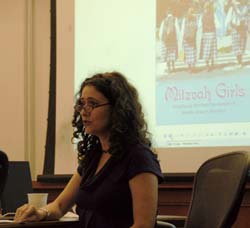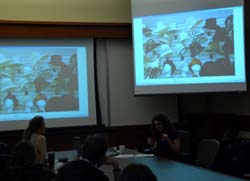The Next Generation of Believers
A BookTalk at TC on femininity in Hasidic culture
When it comes to the traditional female apparel choices of Hasidic women, such as nude (not black) stockings and skirts that hang mid-calf, you can’t always judge a book by its cover. That’s just one of the insights offered by TC alumna Ayala Fader, Associate Professor of Anthropology at Fordham University, in her book, Mitzvah Girls: Bringing Up the Next Generation of Hasidic Jews in Brooklyn (Princeton University Press), which she spoke about at a February 3 BookTalk at TC Gottesman Libraries.
A self-described Jewish feminist who grew up in a Reform household, Fader was drawn initially to her subject by nostalgia for the lives of her great grandparents. She set out to study the exclusive world of Hasidic Judaism in Boro Park Brooklyn, hoping to illustrate the experiences, values and roles of “girls who want to become the next generation of believers.”
“I expected the Hasidic women to be passive and frumpy,” she told her audience, adding that instead, one of the first things she noted was how fluent these women and girls were in pop culture references; how their seemingly conservative fashions were often the product of high-end designers, like Chanel; how they always looked stunning at holidays; and how they showed little hesitation to push ahead in lines at the grocery store.
Indeed, Fader said, it is the duty of Hasidic women and girls to protect the men and boys by filtering, sampling and enjoying secular culture. Referring to the female population’s ease in the secular world, Fader noted, “This way of being ‘with it’ makes the spiritual and material complementary.”
The first book to explore the upbringing of Hasidic Jewish girls in the United States
Another way of straddling the secular and religious worlds is through language. Some mothers observed that their daughters thought English was “fancier” than Yiddish. Many used a standardized hybrid of the language, carefully mixing Yiddish words into the order of a largely English sentence; in this way, the girls are actually changing the meaning of English and making it Jewish.
While what the girls speak is important, how they speak—with modesty—is equally important. Fader says, “Modesty and discipline make the body and soul complimentary, instead of opposing”—which suddenly places the custom of traditional dress, including the need for the right kind of stockings, in a whole new light.
Published Thursday, Mar. 25, 2010

